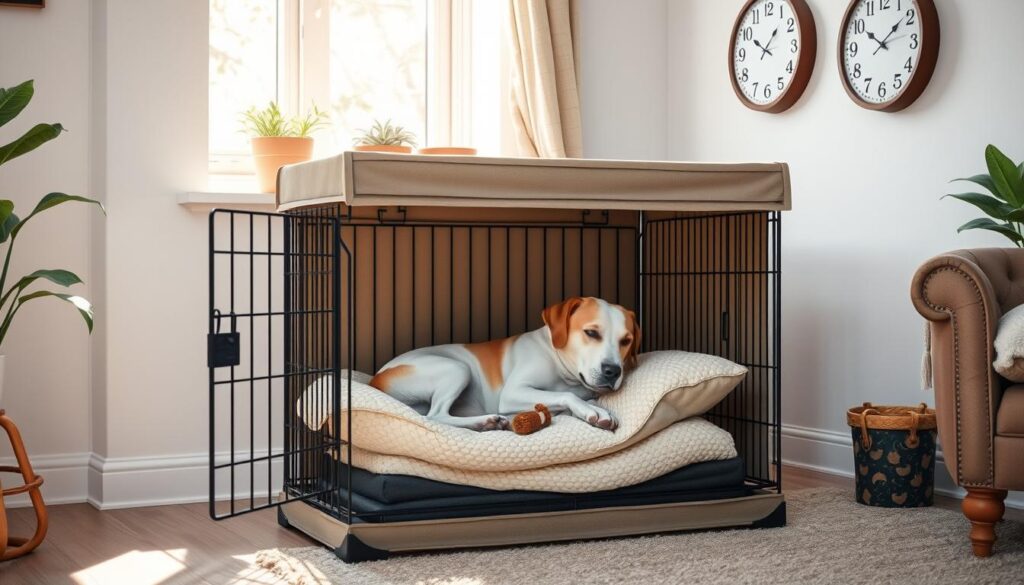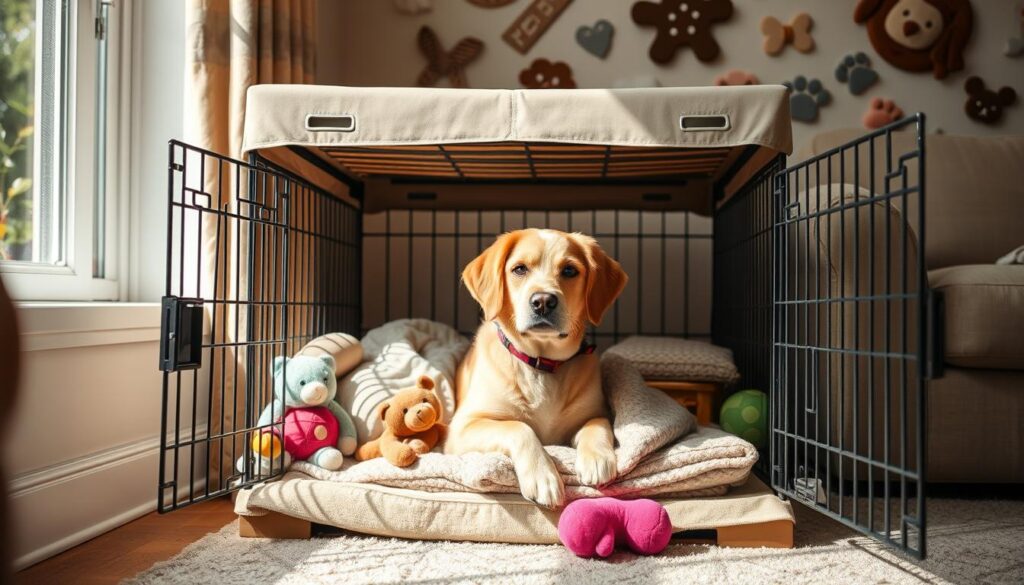Did you know 88% of dog owners think it’s too late to crate train an adult or senior dog? But this is just a myth. The truth is, dogs of any age can learn to love their crate with the right approach.
I’ve seen many adult dogs learn to love their crate, even if they’ve had bad experiences before. The secret is patience and understanding what your dog needs. While puppies might learn fast, older dogs need more time.
Crate training is great for dogs of all ages. It gives them a safe place when they’re stressed, helps them recover from illness, and keeps them safe while traveling. For older dogs, a crate can be a cozy spot to relax and have some quiet time.
Training an older dog might take longer, but it’s possible. Being consistent and using positive reinforcement are key, no matter your dog’s age. By focusing on these, you can help your dog feel comfortable in their new crate.
Key Takeaways
- Dogs can be crate trained at any age
- Adult dogs need more patience during the training process
- Crate training provides safety and comfort for older dogs
- Consistency is important for successful crate training
- Positive reinforcement helps dogs of all ages adapt to crates
- Professional help is available for challenging cases
The Truth About Age and Crate Training Success

Age shouldn’t stop adult dogs from learning. Older dogs can learn new things with the right method. We will look at how to help our older dogs with crate training.
Understanding Adult Dog Learning Patterns
Adult dogs might take longer to learn, but they can do it. Being patient is crucial. Short, consistent training sessions work best. Don’t rush it, or your dog might not like the crate.
Senior Dogs and Crate Adaptation
Training older dogs needs extra care. They might not like small spaces because of discomfort or past experiences. Start with a big crate and make it smaller as they get used to it. For more tips, check out this guide.
Overcoming Age-Related Training Challenges
There are ways to beat age-related challenges in crate training. Here are some effective methods:
| Age Group | Challenge | Solution |
|---|---|---|
| Adult (2-7 years) | Established habits | Gradual introduction, positive reinforcement |
| Senior (8+ years) | Physical discomfort | Comfortable bedding, larger crate size |
| Rescued/Rehomed | Past negative experiences | Slow introduction, treats, toys |
Knowing these age-specific needs helps us tailor training for any dog’s life stage.
Essential Benefits of Crate Training Older Dogs

Crate training is great for older dogs. It’s never too late to start, and it brings big benefits for both you and your dog.
Creating Safe Spaces for Stress Relief
A crate is a safe spot for dogs when they’re stressed. When introduced right, it becomes a cozy place. This is especially important for older dogs, who get stressed easily.
Medical Recovery Support
Crates are super helpful when dogs are recovering from surgery or illness. They help dogs rest and heal without moving too much. This keeps them safe and helps them get better faster.
Travel Safety Advantages
Crates make car rides safer for older dogs. They keep your pet safe and prevent you from getting distracted while driving. In emergencies, a crate-trained dog is easier to move safely.
| Crate Benefit | Impact on Older Dogs |
|---|---|
| Stress Relief | Provides safe space during parties or holidays |
| Medical Recovery | Aids post-surgery healing by limiting movement |
| Travel Safety | Ensures secure car travel and easier emergency evacuation |
Training older dogs to use a crate usually takes 2 weeks to 2 months. Begin with short 5-10 minute sessions. Then, increase by 5 minutes each day. With patience and consistency, your older dog will enjoy the crate’s benefits, making their life better.
Understanding Your Dog’s Crate Training Timeline

The time it takes for a dog to get used to a crate varies. Some dogs pick it up fast, while others need more time. I’ve seen dogs take weeks or months to fully adjust. This depends on their personality, past experiences, and age.
Puppies under 6 months should not be in the crate for more than 3-4 hours. As dogs get older, they can handle longer periods. Adult dogs can stay in the crate for 4-5 hours max. Remember, crate training is a gradual process that requires patience and consistency.
- 8-10 weeks old: 30-60 minutes
- 11-14 weeks old: 1-3 hours
- 15-16 weeks old: 3-4 hours
- 17 weeks and older: 4-5 hours
For the best results, plan for at least six months of training. This allows for proper adaptation and ensures a positive crate experience. Make sure to balance crate time with play, bathroom breaks, and bonding activities outside the crate.
Selecting the Perfect Crate for Adult Dogs

Choosing the right crate for your adult dog is crucial for successful training. I’ll guide you through the most important factors to consider when selecting a crate that meets your pet’s needs.
Size and Comfort Requirements
The ideal dog crate size allows your pet to stand, turn around, and lie down comfortably. Measure your dog from nose to tail and from the top of their head to the floor. This ensures you pick a crate that’s neither too cramped nor too spacious.
Material Options and Durability
Crate materials play a big role in durability and functionality. Wire crates offer maximum airflow and visibility. Plastic crates are great for travel. For escape artists, heavy-duty metal crates might be necessary. Soft crates are less practical due to their lack of durability.
Location Selection in Your Home
Crate placement is critical to your dog’s comfort. Put the crate in a central area like the kitchen or living room. This helps your dog feel included in family activities while in their crate. Keep the door open initially to let your pet roam around freely.
| Crate Type | Pros | Cons | Best For |
|---|---|---|---|
| Wire | Good airflow, visibility | Less den-like | Most dogs |
| Plastic | Den-like, travel-friendly | Less ventilation | Air travel |
| Heavy-duty metal | Escape-proof | Expensive | Escape artists |
| Soft-sided | Lightweight | Easy to escape | Calm, small dogs |
Remember, proper crate training is essential for your dog’s safety and comfort. By choosing the right size, material, and location, you’re setting your adult dog up for crate training success.
Building Positive Crate Associations

Crate training makes your dog’s space welcoming. I start by putting high-value treats inside. Freeze-dried treats, bully sticks, or marrow bones are great choices. Feeding meals in the crate with the door open also helps.
Try putting treats in the closed crate, then open it for your dog. This makes them curious and want to explore. As they get used to it, add more crate time with treats and praise.
Make the crate cozy with a favorite bed or mat. Using old bedding with your scent adds comfort. The crate should be just the right size for your dog to move around comfortably.
Being consistent is crucial in crate training. Use cues for entering and exiting the crate. Start with short times and increase it as your dog gets more comfortable. Wait for calm before opening the door to teach patience.
Using these positive methods, your dog will see the crate as a safe, enjoyable place. This approach works for dogs of all ages, showing it’s never too late to start.
Gradual training process

Starting crate acclimation step by step is best. I begin by feeding meals in the open crate. This helps the dog see the crate as a good place.
As the dog gets used to it, I start closing the door during meals. It’s important to watch for stress signs and open the crate if needed.
The next step is to slowly increase how long the door is closed. I give long-lasting chews and practice stepping away for a bit. This makes the dog feel safe over time.
| Age (weeks) | Max Crate Time |
|---|---|
| 9-10 | 30-60 minutes |
| 11-14 | 1-3 hours |
| 15-16 | 3-4 hours |
| 17+ | 4-6 hours |
Remember, every dog is different. Crate training can take days or weeks. Be patient, especially with puppies under six months. They can’t hold their bladders for long.
Experts say not to use the crate as punishment. This can make the dog feel bad about the crate. Instead, use positive rewards to make the crate a safe, cozy space.
For more on dog training, check out this article.
Addressing Crate Training Setbacks

Crate training can face challenges, even with good intentions. Dogs may show signs of stress that need attention. We will now look at common problems and solutions.
Behavioral Issues
Some dogs may act out in their crate. This can include barking too much or chewing on things they shouldn’t. These behaviors often come from feeling anxious or bored. To help, try giving them puzzle toys or safe chew items to keep them busy.
Stress Signals
It’s important to spot when your dog is stressed. Look for signs like panting, pacing, or whining. If you see these, it’s time to change your approach. Gradually introducing them to the crate and using positive rewards can help.
Adjustment Strategies
Changing behavior can be effective. Begin with short crate times and gradually increase them. Use treats to make crate time positive. If problems continue, seek advice from a professional trainer.
| Issue | Strategy | Success Rate |
|---|---|---|
| Excessive barking | Ignore barking, reward quiet | 75% |
| Anxiety | Gradual exposure | 80% |
| Destructive behavior | Provide appropriate toys | 70% |
Remember, patience is crucial. With consistent effort, most dogs can learn to enjoy their crate. This reduces stress and makes a safe space for them.
Common Challenges in Adult Dog Crate Training

Crate training adult dogs comes with its own set of challenges. Unlike puppies, older dogs have set habits and routines. This makes training them a bit harder, but it’s still doable.
Separation Anxiety Management
Separation anxiety is a big challenge in adult dog training. Dogs with this issue may get anxious when left alone in a crate. They might bark a lot, drool, or try to get out.
To help, start with short crate sessions while you’re there. Then, slowly increase the time as your dog gets used to it.
Previous Negative Experiences
Some adult dogs don’t like crates because of bad past experiences. They might think the crate is a punishment or a place to be locked up. To overcome this, be patient and use positive methods.
Feed their meals near the crate, then inside it. Use treats they love to make the crate a positive place.
Resistance to Change
Older dogs like their routines and might resist crate training. To make the crate appealing, add cozy bedding and their favorite toys. Place the crate in a quiet spot in your home.
Behavior modification is critical to solving these problems. Being consistent and using positive reinforcement helps. With time and patience, most adult dogs can see their crate as a safe, cozy space.
Maximum Time Limits for Adult Dogs in Crates

It’s important to know how long adult dogs should stay in crates. Keeping them confined responsibly is important for their health. Adult dogs should not be in crates for more than 6-8 hours.
- 8-week-old puppy: 2 hours
- 3-month-old puppy: 3 hours
- 4-month-old puppy: 4 hours
- Adult dogs: 6-8 hours maximum
These are the max times. Try to keep crate time short when you can. Long stays can cause physical issues and stress. Make sure your dog gets lots of playtime and attention outside the crate.
If you’re away for a long time, think about dog daycare or a pet sitter.
By sticking to these rules, you’ll help your dog enjoy crate time. This keeps them happy and healthy.
Creating an Effective Crate Training Schedule

A good crate training schedule is essential. Consistency helps dogs adjust fast. Let’s look at daytime and nighttime crating.
Day vs. Night Training Differences
Daytime crating needs patience. Start with short sessions, then increase them. Begin with 5-minute intervals, aiming for 30 minutes in a few days.
Before each session, make sure your dog gets exercise and a potty break. This helps them adjust better.
Nighttime crating is easier for some dogs. Create a bedtime routine. Use a blanket to cover the crate, leaving one side open for you to watch.
Gradual Duration Increases
For daytime crating, follow this schedule:
- Week 1: 5-10 minute sessions, 3 times daily
- Week 2: 15-20 minute sessions, 2-3 times daily
- Week 3: 30-45 minute sessions, 2 times daily
- Week 4: 1-hour sessions, 1-2 times daily
Adjust the schedule as needed. Reward calm behavior and give toys to keep your dog busy. This makes the crate a safe, positive space.
Signs of Successful Crate Training Progress

Seeing your dog’s crate training success means looking for certain behavior changes. A big sign is when they go into the crate on their own. This shows they see it as a safe place, not a punishment.
Another sign is when your dog stays calm in the crate, even with the door shut. If they use the crate to hide during loud storms or when people come over, it’s a good sign. It shows they trust the crate as a safe space.
Remember, every dog is different. Some, especially those from shelters or with separation anxiety, might need more time. Being patient is crucial for long-term success with crate training.
- Willingly enters the crate
- Stays calm when door is closed
- Uses crate as a safe space
- Sleeps peacefully in the crate
Crate training works for dogs of all ages. It keeps older dogs safe, helps with house training, and makes travel easier for them. With regular practice and positive rewards, you’ll see big changes in your dog’s crate behavior.
Special Considerations for Different Age Groups

Crate training isn’t just for puppies. Dogs of all ages can benefit from it. We will look at how to crate train different age groups.
Crate Training Adult Dogs (2-7 years)
Training adult dogs to use a crate takes patience. They may have habits that are hard to change. Use positive reinforcement like treats and praise when they go into the crate on their own.
Start with short sessions and gradually make them longer. Adult dogs are often less easily distracted than puppies, which helps.
Crate Training Senior Dogs (8+ years)
Training senior dogs to use a crate needs extra care. They might have physical or health issues. Choose a crate that’s easy for them to get into and a soft bed.
Introduce the crate slowly, letting them explore at their own pace. Use their favorite treats to make the crate a positive place. Keep training sessions short to avoid tiring them out.
Adapting Techniques for Rescued or Rehomed Dogs
Training rescue dogs requires sensitivity. They may have unknown past experiences with crates. Start by leaving the crate door open, letting them roam around freely.
Never force them inside. Place treats or toys near and inside the crate to encourage them to go in. Progress slowly, respecting their comfort level. If they show severe anxiety or fear, consider professional help.
Remember, every dog is different. Tailor your training to fit your pet’s needs and how they respond. With patience and consistency, dogs of any age can see their crate as a safe, comfortable space.
Maintaining Long-Term Crate Training Success
Using the crate consistently is important for long-term dog behavior success. Even after the initial training, keeping up with crate use is important. It helps keep good habits alive. Crate training is an ongoing effort that changes as your dog grows.
To keep crate habits strong, give treats or toys in the crate sometimes. This keeps the crate a positive place for your dog. Even when not needed, using the crate for short times helps your dog stay used to it. Always remember, the crate is for safety and comfort, not punishment.
As your dog gets older, you might need to change how you use the crate. Senior dogs might need softer bedding or easier access. For all dogs, the crate should be big enough for them to stand, turn, and lie down comfortably. By adjusting to your dog’s needs, you’ll keep crate training successful and positive for your pet’s whole life.


